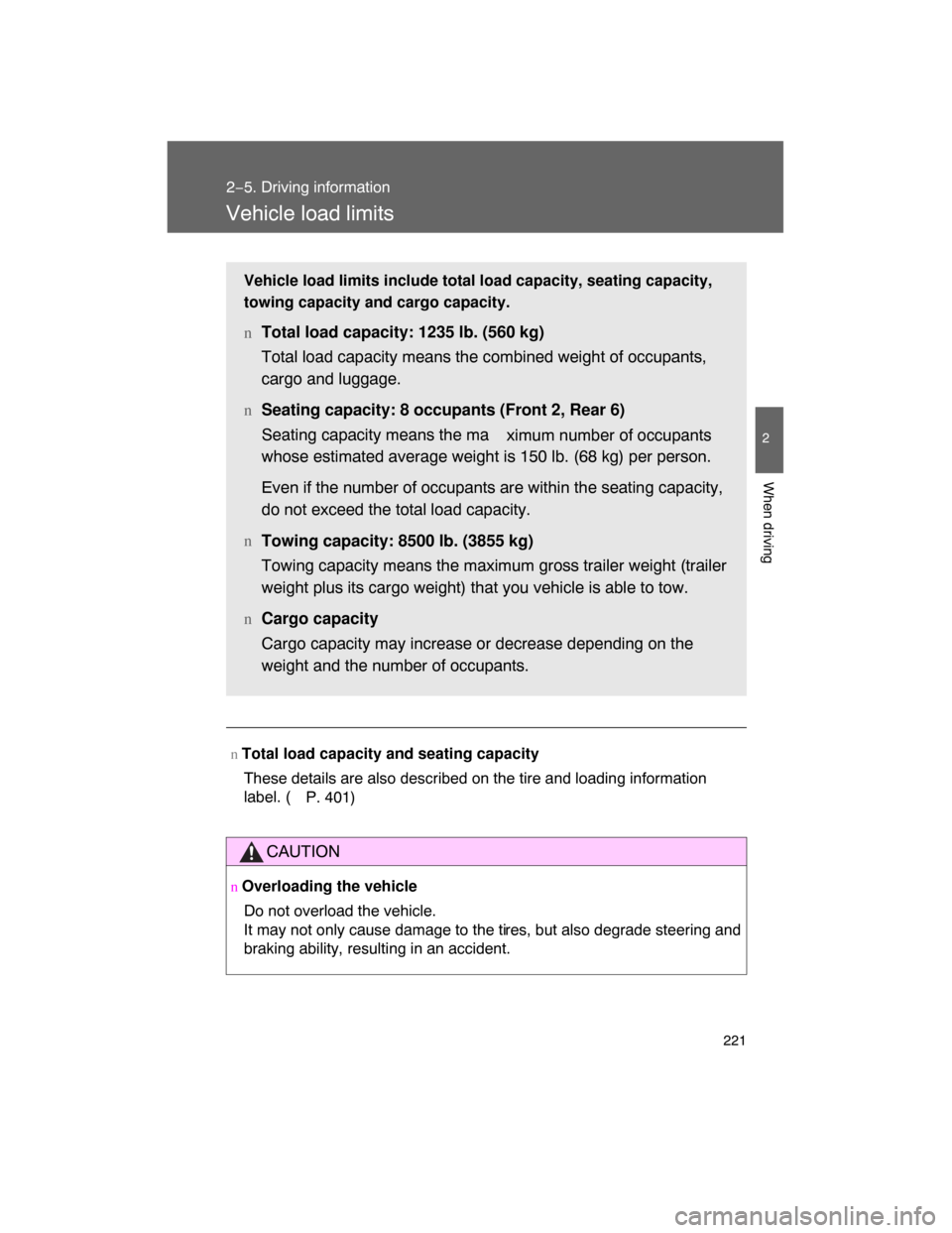Page 155 of 531

157
2−1. Driving procedures
2
When driving
n“S” mode
When the shift range is “5” or lower, holding the shift lever toward “+” sets
the shift range to “6”.
nDownshifting restrictions warning buzzer (in the “S” mode)
To help ensure safety and driving performance, downshifting operation may
sometimes be restricted. In some circumstances, downshifting may not be
possible even when the shift lever is operated. (The warning buzzer will
sound twice.)
nWhen driving with the cruise control system
The engine brake will not operate in
the “S” mode, even when downshifting
to “5” or “4”. (P. 178)
nSecond start mode automatic deactivation
Second start mode is automatically deactivated if the engine is turned off
after driving in second start mode.
n
If the shift lever cannot be shifted from “P”
P. 478
nIf the “S” indicator does not come on even after shifting the shift lever
to “S”
This may indicate a malfunction in the automatic transmission system. Have
the vehicle inspected by your Toyota dealer immediately.
(In this situation, the vehicle will operate as if the shift lever is in “D”.)
nAI�SHIFT
The AI−SHIFT automatically shifts the gear to the optimal position according
to the driver performance and driving conditions.
The AI−SHIFT automatically operates when the shift lever is in the “D” posi−
tion. (Shifting the shift lever to the “S” position cancels the function.)
Page 168 of 531
170
2−3. Operating the lights and wipers
Headlight switch
Turning on the high beam headlights
With the headlights on, push
the lever forward to turn on the
high beams.
Pull the lever back to the center
position to turn the high beams
off.
Pull the lever toward you to
turn on the high beams.
Release the lever to turn them off.
You can flash the high beams
with the headlights on or off. The headlights can be operated manually or automatically.
The side marker, park−
ing, tail, license plate
and instrument panel
lights turn on.
The headlights and all
lights listed above turn
on.
The headlights and all
lights listed above turn
on and off automati−
cally.
(When the “ENGINE
START STOP” switch is
in IGNITION ON
mode.)
ITY23C001
Page 173 of 531
175
2−3. Operating the lights and wipers
2
When driving
NOTICE
nWhen the windshield is dry
Do not use the wipers, as they may damage the windshield.
nWhen there is no washer fluid spray from the nozzle
Damage to the washer fluid pump may be caused if the lever is pulled
toward you and held continually.
nWhen a nozzle becomes block
Do not try to clear it with a pin
or other object. The nozzle will be damaged.
Page 177 of 531
179
2−4. Using other driving systems
2
When driving
nCruise control can be set when
lThe shift lever is in the “D” or “4”, “5” or “6” range of “S”.
lVehicle speed is more than approximately 25 mph (40 km/h).
nAccelerating
The vehicle can be accelerated normally. After acceleration, the set speed
resumes.
nAutomatic cruise control cancelation
The set speed is automatically canceled in any of the following situations.
lActual vehicle speed falls more than 10 mph (16 km/h) below the preset
vehicle speed.
At this time, the memorized set speed is not retained.
lActual vehicle speed is below 25 mph (40 km/h).
l
VSC is activated.
nCanceling and resuming regular acceleration
Cancel
Push the lever towards you to
cancel cruise control.
The speed setting is also can−
celed when the brakes are
applied.
Resume
To resume cruise control and
return to the set speed, push
the lever up.
Page 186 of 531

188 2−4. Using other driving systems
nSensor detection information
lCertain vehicle conditions and the surrounding environment may affect
the ability of the sensor to correctly detect obstacles. Particular instances
where this may occur are listed below.
�There is dirt, snow or ice on the sensor. (Wiping the sensor will resolve
this problem.)
�The sensor is frozen. (Thawing the sensor will resolve this problem.)
�The sensor is covered in any way.
�In harsh sunlight or intense cold weather.
�When driving on bumpy, sloped or gravel roads, or over grass.
�If there is something producing ultrasonic waves nearby, such as
another vehicle’s horn, motorcycle engine noise, air braking sound
from heavy−duty vehicles, or another vehicle using the park assist sys−
tem.
�In heavy rain, or if water is splashed on the sensors.
�The vehicle is leaning considerably to one side.
�If a commercial fender pole or radio antenna is installed.
�If moving towards a high curb or a curb corner.
�If towing eyelet is installed on your vehicle.
�The bumper or sensor receives a strong impact.
�A non−genuine Toyota suspension (lowered suspension etc.) is
installed.
In addition to the examples above, there are instances in which, because of
their shapes, signs and other objects may be judged by the sensor to be
closer than they are.
lThe shape of the obstacle may prevent the sensor from detecting it. Pay
particular attention to the following obstacles.
�Thin objects such as wire, fencing or rope.
�Objects that absorb sound waves, such as cotton or snow.
�Objects with sharp corners.
�Low objects.
�Objects where the upper section projects out over the lower section.
Page 212 of 531
214
2−5. Driving information
Cargo and luggage
Take notice of the following information about storage precau�
tions, cargo capacity and load.
lStow cargo and luggage in the luggage compartment when−
ever possible. Be sure all items are secured in place.
lBe careful to keep the vehicle le vel. Placing the weight as far
forward as possible helps maintain vehicle balance.
lFor better fuel economy, do not carry unnecessary weight.
n
Roof luggage carrier
Roof rails
Cross rails
1
2
ITY25C039
Page 214 of 531

216 2−5. Driving information
Capacity and distribution
Cargo capacity depends on the total weight of the occupants.
(Cargo capacity) = (Total load capa
city) — (Total weight of occupants)
Steps for Determining Correct Load Limit—
(1) Locate the statement “The co
mbined weight of occupants and
cargo should never exceed XXX kg or XXX lbs.” on your vehi−
cle’s placard.
(2) Determine the combined weight of the driver and passengers
that will be riding in your vehicle.
(3) Subtract the combined weight of
the driver and passengers from
XXX kg or XXX lbs.
(4) The resulting figure equals the available amount of cargo and
luggage load capacity.
For example, if the “XXX” amount
equals 1400 lbs. and there will
be five 150 lb passengers in your vehicle, the amount of avail−
150) = 650 lbs.)
(5) Determine the combined weight of luggage and cargo being
loaded on the vehicle.
That weight may not safely ex
ceed the available cargo and lug−
gage load capacity calculated in Step 4.
(6) If your vehicle will be towing a trailer, load from your trailer will
be transferred to your vehicle. Consult this manual to determine
how this reduces the available cargo and luggage load capacity
of your vehicle. (
P. 221)
Page 219 of 531

221
2−5. Driving information
2
When driving
Vehicle load limits
n Total load capacity and seating capacity
These details are also described on the tire and loading information
label. (
P. 401)
CAUTION
n Overloading the vehicle
Do not overload the vehicle.
It may not only cause damage to the ti
res, but also degrade steering and
braking ability, resulting in an accident.
Vehicle load limits include total load capacity, seating capacity,
towing capacity and cargo capacity.
nTotal load capacity: 1235 lb. (560 kg)
Total load capacity means the combined weight of occupants,
cargo and luggage.
n
Seating capacity: 8 occupants (Front 2, Rear 6)
Seating capacity means the ma
ximum number of occupants
whose estimated average weight is 150 lb. (68 kg) per person.
Even if the number of occupants are within the seating capacity,
do not exceed the total load capacity.
n
Towing capacity: 8500 lb. (3855 kg)
Towing capacity means the maximum gross trailer weight (trailer
weight plus its cargo weight) that you vehicle is able to tow.
n
Cargo capacity
Cargo capacity may increase or decrease depending on the
weight and the number of occupants.